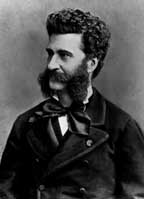 |
Johann Strauss
| Waltz King -- Johann Strauss --Bulgakov's notes from the Brokgauz-Efron
Encyclopedia include the name of the Austrian composer Johann Strauss (1829-1899).
In the encyclopedia article he is referred to as the "King of Waltzes." |
 |
Johann Strauss, Jr., b. Oct. 25, 1825, d. June 3, 1899, became a musician
against his father's wishes. After studying the violin in secret with the
encouragement of his mother, he then began the serious study of composition.
At the age of 19 he formed his own orchestra, playing in the cafes of Vienna,
and soon eclipsed his father in popularity. Upon his father's death in 1849,
both orchestras were merged under his direction. With that group he toured
widely, visiting Russia in 1865, England in 1869, and the United States
in 1876. Everywhere he and his music were greeted with great enthusiasm.
In all, Strauss composed about 170 waltzes--the most beloved being "The
Beautiful Blue Danube" (1867), "Artists' Life" (1867), "Tales
of the Vienna Woods" (1868), "Wine, Woman, and Song" (1869),
"Roses from the South" (1880), and "The Emperor Waltz"
(1888)--and many polkas, quadrilles, and marches, totaling about 500 works.
Of his 16 operettas, Die Fledermaus (The Bat, 1874) and Der Zigeunerbaron
(The Gypsy Baron, 1885) were the most successful.
Bibliography: Ewen, David, Tales from the Vienna Woods: The Story of
Johann Strauss (1944); Gartenberg, Egon, Johann Strauss: The End of an Era
(1974; repr. 1979); Jacob, Heinrich E., Johann Strauss, Father and Son,
trans. by Marguerite Wolff (1939; repr. 1971); Wechsberg, Joseph, The Waltz
Emperors (1973).
from the Grolier Multimedia Encyclopedia, 1997 |